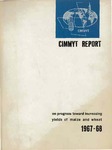Mostrar el registro sencillo del ítem
CIMMYT Report 1967-68: On progress toward increasing yields of maize and wheat
| Año: | 1968 |
| URI: | http://hdl.handle.net/10883/1345 |
| Resumen: | During the past year CIMMYT strengthened its research and training in Mexico and enlarged the network of cooperative research and production programs in the tropical and subtropical areas of the world. In addition to directing central research projects, many CIMMYT staff are involved in developing new cooperative programs and in assisting scientists of various countries in the solution of local and regional problems which have obstructed increases in maize and wheat production. New staff members have been added and the central training programs enlarged to more effectively meet demands for technical assistance, materials and information. The hard-core group of CIMMYT scientists, together with an increasing number of outstanding scientists and policy makers in cooperating countries, are catalyzing a series of events leading to an upward spiral in wheat and maize production throughout the tropics and semi-tropics. The major effort of this group is concentrated on the development and utilization of better varieties and production practices. The new high yielding varieties of wheat, developed in Mexico in cooperation with INIA and other local agencies, have sparked a yield revolution in India and Pakistan which is helping to alleviate hunger. The desire for this kind of a revolution has spread to other wheat-deficit countries of the Middle East and North Africa. As a result the Mexican dwarf varieties are improving the well-being of millions of people in widely separated areas of the world. About 13 million acres, 7112 times more than the total area sown to wheat in Mexico, are now planted to these varieties. In maize, new germ plasm complexes made up of prevailing Latin American races have gone out to the various maize growing areas of' the tropics to serve as basic breeding materials for the development of new hybrids and open pollinated varieties. These germ plasm complexes are changing the breeding and production techniques in Latin America and are revealing higher yield possibilities for corn production in Southeast Asia and parts of Africa. New cooperatively developed varieties and hybrids are now going into production in Mexico, Central America, Venezuela, Colombia, Ecuador, Peru, Brazil and Argentina..Open pollinated varieties such as J1, developed from introducedmaterials in India, are moving into West Pakistan and Nepal. The varieties coming out of the cooperative program in Thailand are opening up new horizons for corn production in Southeast Asia. |
| Formato: | |
| Lenguaje: | English |
| Editor: | CIMMYT |
| Nombre de la Serie: | CIMMYT Annual Report |
| Copyright: | CIMMYT manages Intellectual Assets as International Public Goods. The user is free to download, print, store and share this work. In case you want to translate or create any other derivative work and share or distribute such translation/derivative work, please contact CIMMYT-Knowledge-Center@cgiar.org indicating the work you want to use and the kind of use you intend; CIMMYT will contact you with the suitable license for that purpose. |
| Tipo: | Annual Report |
| Lugar de publicación: | Mexico, DF (Mexico) |
| Páginas: | 99 pages |
| Agrovoc: | ZEA MAYS |
| Agrovoc: | WHEAT |
| Agrovoc: | PLANT BREEDING |
| Agrovoc: | CEREALS |
| Agrovoc: | TRITICOSECALE |
| Agrovoc: | DISEASE RESISTANCE |
| Agrovoc: | EXPERIMENTATION |
| Agrovoc: | TRAINING |
| Agrovoc: | FINANCE |
| Agrovoc: | RESEARCH INSTITUTIONS |
| Agrovoc: | REGIONAL PLANNING |
| Agrovoc: | GENE POOLS |
| Agrovoc: | GENETICS |
| Agrovoc: | CYTOGENETICS |
| Agrovoc: | BREEDING METHODS |
| Agrovoc: | PROTEIN QUALITY |
| Agrovoc: | PATHOLOGY |
| Agrovoc: | ENTOMOLOGY |
| Autor corporativo: | Centro Internacional de Mejoramiento de Maíz y Trigo (CIMMYT) |
Ficheros en el ítem
Este ítem aparece en la(s) siguiente(s) colección(ones)
-
Institutional
Collection of CIMMYT institutional documents

